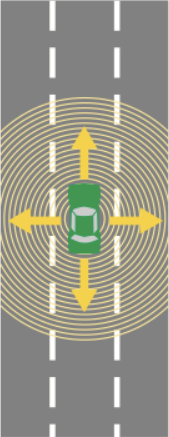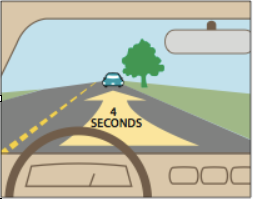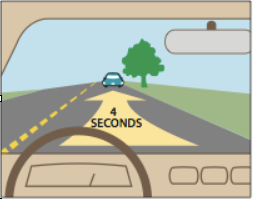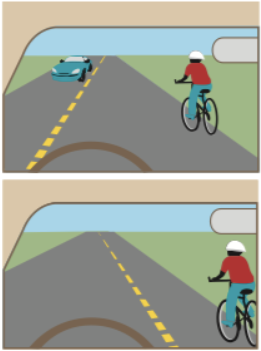Session 25 – Cushion of Space
CUSHION OF SPACE
You must always share the road with others. The more distance you keep between yourself and everyone else, the more time you have to react. This space is like a safety cushion. The more you have, the safer you will be. This section describes how to make sure you have enough space around you when you drive.

Space Ahead
Rear-end crashes are very common. They are caused by drivers following too closely (tailgating) to be able to stop before hitting the vehicle ahead when it suddenly slows or stops.
Professionals used to think a safe following distance of two seconds was enough. They now feel it should be no less than four seconds under ideal conditions. Here is an easy way to find out if you are following too closely.

Following-distance rule: Watch for when the rear of the vehicle ahead passes a sign, tree or any other stationary point. Consider it to be your “mark.”
Count the seconds it takes you to reach the same mark. (“One-thousand- one, one-thousand-two, one-thousand-three, one-thousand-four.”)
You are following too closely if you pass the mark before you finish counting. If so, drop back and then count again at another mark to check the new following distance. Repeat until you are following no
closer than the minimum recommended following distance.
A minimum four-second following distance is recommended under ideal driving conditions. However, in the following situations, you may need more following distance to be safe:
- on slippery roads. Because you need more distance
to stop your vehicle on slippery roads, you must leave more space in front of you. If the vehicle ahead suddenly stops, you will need the extra distance to stop safely. - when the driver behind you wants to pass. Slow down to allow room in front of your vehicle. Slowing also will allow the pass to be completed sooner.
- when following motorcycles or bicyclists. If the cycle should fall, you need extra distance to avoid hitting the rider. The chances of a fall are greatest on wet or icy roads, gravel roads or metal surfaces such as bridges, gratings or railroad tracks.
- when following drivers who cannot see you. The drivers of trucks, buses, vans or vehicles pulling campers or trailers may not be able to see you when you are directly behind them. This “blind spot” to the rear of large trucks can extend for 200 feet! They could stop suddenly without knowing you are there. Large vehicles also block your view of the road ahead. Falling back allows you more room to see ahead.
- when you have a heavy load or are pulling a trailer. The extra weight increases your stopping distance.
- when it is hard for you to see because of darkness or bad weather. You need to increase your following distance so you can see ahead, or have time to get stopped if it’s necessary.
- when being followed closely. You should allow extra room so you will be able to stop without being hit from behind.
- when following emergency vehicles. Police vehicles, ambulances and fire trucks need more room to operate.
- when approaching railroad crossings. Leave extra room for vehicles required to come to a stop at railroad crossings, including transit buses, school buses or vehicles carrying hazardous materials (gasoline tankers, etc.)
- when stopped on a hill or incline. Leave extra space because the vehicle ahead may roll back when it starts moving.
Space Behind
It is not always easy to maintain a safe distance behind your vehicle. However, you can help a driver behind you maintain a safe distance by keeping a steady speed and signaling in advance when you have to slow down or turn.

Try to find a safe place out of traffic if you need to stop to pick up or let off passengers.
If you want to parallel park and there is traffic coming behind you, put on your turn signal, pull next to the space, and allow vehicles behind you to pass before you park.
If you are driving more slowly than other traffic on a multi-lane road, drive in the right most travel lane. When you have to drive so slowly that you slow down other vehicles, pull to the side of the road when safe to do so and let them pass. There are “turnout” areas on some two-lane roads you can use. Other two-lane roads sometimes have “passing lanes.”
Every now and then you may find yourself being followed too closely or being “tailgated” by another driver. If you are being followed too closely and there is a right lane, move over to the right. If there is no right lane, wait until the road ahead is clear and passing is legal, then slowly reduce speed. This will encourage the tailgater to drive around you. Never slow down quickly to discourage a tailgater.
All that does is increase your risk of being hit from behind.
Caution: This is especially true if you are being followed by a large truck or bus, neither of which can stop as quickly as a car. Give large vehicles extra room to move.
Space to the Side
You need space on both sides of your vehicle to have room to turn or change lanes.
Avoid driving next to other vehicles on multi-lane roads. Someone may crowd your lane or try to change lanes and run into you. Move ahead or drop back from the other vehicle.
Keep as much space as you can between yourself and oncoming vehicles. On a two-lane road, this means not crowding the center line. In general, it is safest to drive in the center of your lane.
Make room for vehicles entering a roadway with two or more lanes. If there is no one next to you, move over to the next lane.
Keep extra space between your vehicle and parked cars. Someone could step out from a parked vehicle or from between vehicles, or a parked vehicle could suddenly pull out.
Give extra space to pedestrians and bicyclists, especially children. They can move into your path quickly and without warning. Do not share a lane with a pedestrian or bicyclist. Wait until it is safe to pass in the adjoining lane. Bicycles are vehicles, and are entitled to a full traffic lane. Give a bicycle at least three feet of room when you pass.
Give snowplows as much room as possible. They often need to operate very close to the centerline, and sometimes throw up clouds of snow affecting your vision.
“Split the difference” between two hazards. For example, steer a middle course between oncoming traffic and parked vehicles. However, if one is more dangerous than the other, leave a little more space on the dangerous side. For example, if the oncoming vehicle is a semi-truck, leave a little more room on the side the truck will pass.
When possible, take potential hazards one at a time. For example, if you are meeting or passing a bicycle or a motorcycle and an oncoming vehicle is approaching, slow down and let the vehicle pass first so you can give extra room to the bicycle or motorcycle.

Space to Merge
Anytime you want to merge with other traffic, you need a gap large enough to safely move into the flow of traffic. You need a minimum four-second gap whenever you change lanes, enter a roadway or when your lane merges with another travel lane.
Do not try to merge into a gap that is too small. A small gap can quickly become even smaller. Enter a gap that gives you a big enough space cushion to be safe.
If you want to cross several lanes, take them one at a time. Like going up or down stairs one step at a time, it is safest and easiest to merge one lane at a time. It is very difficult to determine that all the lanes are free and safe to cross. If you wait until all the lanes are clear, you can tie up traffic and even cause a crash.
Space to Cross or Enter
When you cross traffic, you need a large enough gap to get all the way across the road. When you enter traffic, you need enough space to first turn or enter and then to get up to speed.
When you cross traffic, you need room to get all the way across. Stopping halfway across is only safe when there is a median divider large enough for your vehicle. Do not stop in a divider where part of your vehicle will be in the way of other traffic.
If you are turning left, make sure there are no vehicles or pedestrians blocking your path. You do not want to be caught waiting for a path to clear while you are stopped across a lane with vehicles coming toward you.
Never assume another driver will share space with you or give you space. For example, do not turn just because an approaching vehicle has a turn signal on. The driver may plan to turn after they pass your vehicle or they may have forgotten to turn off the signal after a prior turn. This is particularly true of motorcycles, as their signals often do not cancel by themselves. Wait until the other driver actually starts to turn and then go if it is safe to do so.
When you cross railroad tracks, make sure you can cross without having to stop on the tracks.
Space to Pass
Whenever signs or road markings permit you to pass, you will need to judge whether you have enough room to safely pass.
Do not count on having enough time to pass several vehicles at once. Be safe. As a general rule pass only one vehicle at a time and pass on the left side. Do not linger in the passing lane. Get around the vehicle as quickly as possible and move safely back into your lane. Remember… you may not exceed the speed limit to pass.
Oncoming vehicles: At a speed of 55 mph, you need about 10 seconds to pass. That means you need a 10-second gap in oncoming traffic and sight distance to pass. You must judge whether you will have enough space to safely pass.
At 55 mph you will travel over 800 feet in 10 seconds; so will an oncoming vehicle. That means you need over 1,600 feet or about one-third of a mile to safely pass. It is hard to judge the speed of oncoming vehicles at this distance.
Caution: This is especially true with large trucks, which, because of their size, often appear to be moving slower than they
really are. A vehicle that is far away generally appears to be standing still. In fact, if you can actually see that it is coming closer (getting larger), it may be too close for you to pass.
At night, it is especially hard to judge distance and speed of oncoming traffic. If you are not sure, wait to pass until you are sure there is enough space.
Hills and curves: You need to be able to see at least one-third of a mile or about 10 seconds ahead. Anytime your view is blocked by a curve or a hill, you should assume there is an oncoming vehicle just out of sight. Therefore, you should treat a curve or a hill as you would an oncoming vehicle. This means you should not start to pass if you are within one-third of a mile of a hill or curve.
Intersections: It is dangerous to pass where a vehicle is likely to enter or cross the road. Such places include intersections, railroad crossings and shopping center entrances. While you are passing, your view of people, vehicles or trains can be blocked by the vehicle you are passing. Also, drivers turning right into the approaching lane will not expect to find you approaching in their lane. They may not even look your way before turning.
Passing large trucks: A typical car is 15 feet long. A multiple-trailer truck can be 75 feet long or longer. It can take much longer to pass a truck than it would to pass a car; therefore, you must have more clear road ahead before you can safely pass.
Lane restrictions: Before you pass, look ahead for road conditions and traffic that may cause other vehicles to move into your lane. You might lose your space for passing because of:
- people or animals near the road,
- a narrow bridge or other situation that causes reduced lane width,
- a patch of ice, pot hole or something on the road.
Space to return: Do not pass unless there is enough space in front of the vehicle you want to pass. Do not count on another driver to make room for you.
Before you return to the driving lane, be sure to leave enough room between you and the vehicle you have passed. When you can see both headlights of the vehicle you just passed in your rear-view mirror, it is safe to return to the driving lane.
Railroad grade crossing: Do not pass if there is a railroad grade crossing ahead.
Space for Dangerous Situations
You should give extra room to certain drivers and other road users. Some are listed here.
Those who cannot see you. Anyone who cannot see you may enter your path without knowing you are there. Those who could have trouble seeing you include:
- drivers at intersections or driveways where their view is blocked by buildings, trees or other vehicles,
- drivers backing into the roadway or backing into or pulling out of parking spaces,
- drivers whose windows are steamed up or are covered with snow or ice,
- pedestrians with umbrellas in front of their faces or with their hats pulled down,
- pedestrians with white canes and/or dog guides.
People who are distracted. Even when others can see you, allow extra room or be extra cautious if you think they may be distracted. People who may be distracted include:
- delivery persons,
- construction workers,
- children,
- drivers who are not paying attention to their driving.

People who may be confused. People who are confused may cause an unsafe situation. People who may be confused include:
- persons driving cars with out-of-state plates, (especially at complicated intersections),
- drivers who slow down for what seems like no reason,
- drivers looking for street signs or house numbers,
- pedestrians who have been drinking.

Large vehicles and wide loads
- Large trucks and buses cannot accelerate, stop, or change direction as quickly as smaller vehicles. Give large vehicles extra room to move on the road, including in roundabouts where they are making turns or going through the roundabout.
- Wide loads. Sometimes extra-wide loads are transported on highways. Give “wide loads” as much room as possible.
Drivers in trouble. If another driver makes a mistake (drivers who pass you when they do not have enough room, for example), do not make it worse. Slow down and let them safely return to the driving lane. If another driver needs to suddenly change lanes, slow down and let them merge. These gestures will keep traffic moving smoothly and safely.
Farm Safety/Rural Driving
You should be aware of special hazards in rural areas. These may include slow moving tractors, horse driven wagons or carriages, people on horseback, farm machinery exiting fields or on the roadway, wide machinery, debris on the road, and livestock on or crossing the highway. Farm machinery operators may have difficulty seeing or hearing other traffic, and the machinery may not have brake lights or turn signals. Use caution and exercise patience when farm machinery is on the road.
Note: No one may let a child under the age of 16 years of age operate a farm tractor or self propelled farm machinery on the highways unless the child has successfully completed a tractor and machinery operation safety training course and is certified to operate such a vehicle. (Check with your local Technical College for these courses.)
You should yield the right-of-way to livestock on or along the highway. Be courteous to and aware of people riding horseback or driving a horse drawn carriage or wagon. You can help to avoid scaring the horse by slowing down and keeping a safe distance away while passing them.
